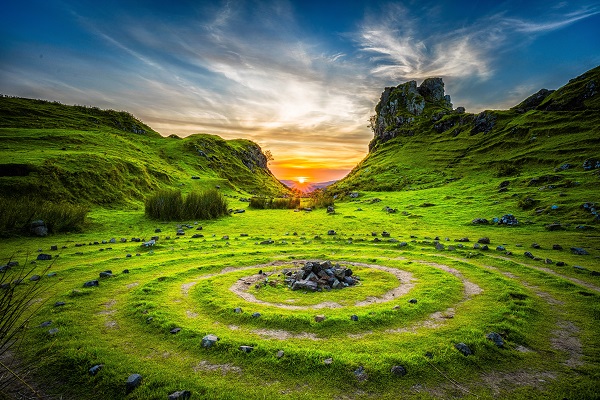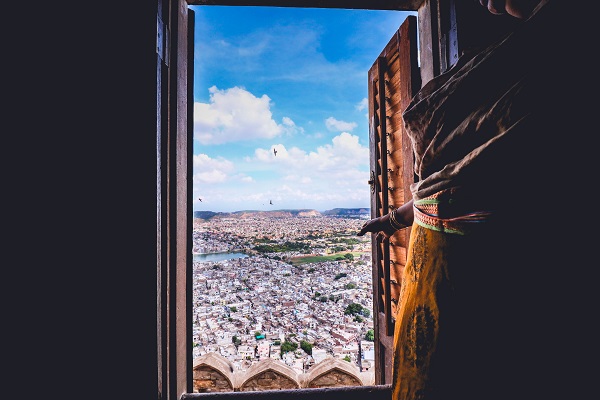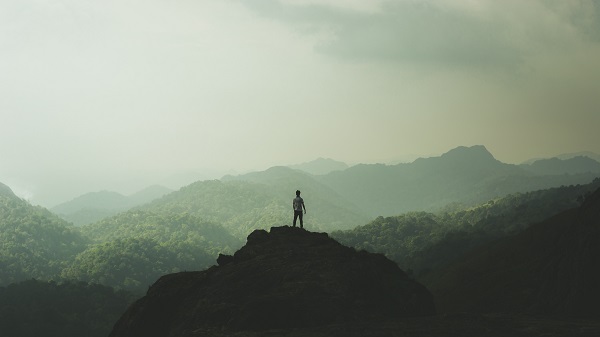World-building is essential for believable, relatable, well-rounded storytelling. It can help to create mood and atmosphere, build character, and evoke a powerful sense of place and setting.
Whether you’re creating sprawling imaginary lands in fantasy works, alternate realities in science fiction and dystopia, or the textured real worlds of historical fiction or literary narratives – it all involve world-building.
But is it possible to fit all of this in when you’re writing a short story, rather than a novel?
The short answer is yes. You just need to craft your world a little differently.
World-building in short stories vs. novels
In a short story, think of world-building like a taste test. In a novel, it’s more like picking an ice cream, then going back to ask how and where it was made, what its origins and history are, and whether you can have another one.
Does this mean the world of a short story should be less developed than in a novel? Or is there just a faster way to reveal the intricacies of the world to your readers?
SFF writer Ian McHugh wrote a neat little blog post on the topic, in response to a Guardian article suggesting world-building for fantasy can’t be done in an independent short story. As McHugh asserts:
The world building needs of the [short] story are less, because you’re opening a smaller window than a novel, holding the reader and suspending their disbelief for a shorter time. And secondly, all you need to do is give the reader’s imagination something to work with, and that doesn’t actually need to take very many words.
McHugh also quotes Andrew Stanton, a screenwriter famed for such Pixar classics as Toy Story and Wall-E, who says storytelling is the well-organised absence of information – which is precisely how world-building works.
Your reader will do a lot of the work themselves in imagining a world from just a few hints. What’s more, they’ll find a sense of enjoyment and satisfaction in that process, as opposed to being spoon-fed the information.
So, we now know the main difference between world-building in a short story and a novel is that the short story world is glimpsed through a smaller window; a peephole, even.
For more insight on how this peephole can give readers the clearest, most intriguing and exciting glimpse into your world while also supporting your story goals, read on.
What counts as world-building?
A fully realised world is one that appears to extend beyond the pages of the story.
In Crafting Novels and Short Stories, Donald Maass explains that the world of narrative does not just mean locations in which the action is set, but also ‘milieu, period, fashion, ideas, human outlook, historical moment, spiritual mood, and more.’
In Maass’ words, world-building encompasses the following:
It is capturing not only place, but people in an environment; not only history, but people changing as the story unfolds. Description is the least of it. Bringing people alive in a place and time is the essence of it.

While he is talking about novel-writing predominantly, these rules don’t change for shorter fiction.
In a short story, you just need to drop the readers straight into an established world, without needing to explain everything about it.
This means your world-building can’t be too complex, otherwise it will take away from the strength of the characters.
This doesn’t mean that your research can’t be thorough; it’s common to do much more work world-building behind the scenes than appears in the finished story.
Just make sure you don’t get distracted by building the world, and forget about writing your story!
If you enjoy the process of getting to know your fictional world in depth, World Anvil Worldbuilding is a fun, interesting resource for creating your own worlds. Otherwise, a pen and paper can be just as handy.
How much research you put into world-building depends on how complex and far from your present experience your world is, and on whether you’re a plotter or a pantser.
Perhaps you want to just see where the story takes you, and add in or fine-tune relevant and specific details to flesh out your world afterwards.
Choose the most relevant world-building details
Below is a basic list of things to consider when building your short story world.
Try to focus on those that are most relevant for your story, and remember, most of this information isn’t going to make it into the final edit. It’s just to help you extend the world beyond the pages of the story.
- Geography
- Describe the natural world.
- Are there any locations of particular significance to your main character?
- What’s the weather like? What season is it in your story?
- People
- Are their different races/species of people (or beings) in your world? How does this impact your main character?
- What languages are spoken? Are there different dialects?
- Think about social frameworks: class systems, familial structure, healthcare, schooling, etc.
- Civilisation
- What’s the history of your world? What historical elements are most pertinent to your character’s plight?
- Explore the culture(s) present in your world and the practices (food and drink, ritual, behaviour) that come along with them.
- Is religion a factor in your character’s life?
- What do people do for fun in your world?
- How educated is your character and why?
- Technology
- Are there systems of magic in your world? How do they work?
- What are the recent technological advancements and how do they impact your character’s day-to-day life?
- What kind of weaponry is used? This is particularly relevant for genres like epic fantasy, historical fiction, or war stories.
- Economy
- How does trade and commerce work in your world? Does this impact your character’s profession?
- What kinds of transportation are common (or uncommon)?
- What kinds of businesses would your character pass when walking down the street? (Are there even streets in your world?!)
- Politics
- Think about who makes up the government, or what kind of government is in power, if any.
- Are there particular laws that have a notable impact on your main character?
Remember that just looking at one of these aspects alone might create the basis of your entire world.
If (as an entirely random, hypothetical example) a virus broke out in a small market stall in a busy pocket of your world, you can imagine how it would affect medical research, the economy, world politics, the way people interact (or don’t) on the street, the relevance of a particularly bitter winter, and so on.

Just as you would for a novel, think about the aspects of world-building that are most crucial to your narrative and your protagonist.
Perhaps you’re focussing on a fantastical class system categorised predominantly by which planet a being comes from, or maybe you want to develop an inter-tribal trade system of goods and services inspired by real-world Native American trade routes.
If your story is focussed around a five-year-old and their desire to tag along on their older sibling’s adventures, perhaps these systems aren’t really all that relevant on first glance, and you’d do better to focus on geographical features or nuances of language.
But if the five-year-old makes friends with a stowaway Martian, or your world is one built around a child slave trade, suddenly these elements become extremely significant.
Focus on the perspective of your main character
Whether your story is written in first, third or even second person, you need to show readers your world from the point of view of your protagonist/s.
Rendering specific details as described and lived by your characters will truly make your world come to life.
To begin with, make sure you have a strong grasp of basic short story structure. Your short story should be built around one or two main characters, with only a handful of characters in total.
It can also end at the climax or have a very minimal (one sentence, even) resolution.
The protagonist needs to have a goal, face obstacles along the way, and ultimately experience change in the process of getting what they want (or not, or something in between).
If this structure is solid, world-building simply makes the protagonist and their quest more interesting and believable.
If the protagonist is in a world significantly different to our own, their plight should nevertheless be recognisable, garnering empathy from the reader as they’re given insight into the character’s inner journey.
In essence, a character’s wants and needs likely won’t be so different from our own. Someone living in the middle of the Amazon is not, at their core, completely different from someone living in a Swedish palace.
Don’t get distracted
Make sure that the world-building in your story serves a purpose beyond telling your reader that there’s a really cool and intricate backstory for your character and their entire ancestry, which you spent five weeks creating.
Lots of your best world-building will never make it into a short story, but that doesn’t mean it hasn’t served its purpose in making the world appear richer and more believable to readers.
If you know the world you’re writing about inside and out, your characters’ actions and encounters will be more authentic and resonant.
As we outlined above, readers want to see and comprehend the world through the eyes of the character, not through the godlike eyes of the author.
Treat your reader with respect – don’t mansplain to them! They’ll have more fun that way, and stay engaged even after the story is over.

Every word matters
A short story is, obviously and by definition, short. Much, much shorter than a novel.
This means you won’t be able to describe every aspect of your world in a short story – though, arguably, you wouldn’t even be able to do that in a full-length novel, and if you did, the world would be very boring.
A short story world can’t be quite as epic and sprawling as, say, the most famous example of world-building: The Lord of the Rings.
Unlike Tolkien, you won’t be able to include songs in your own made-up languages, explain the history and society of several races of characters, or spend entire chapters describing forests or swamps.
You might have snippets of this, though: a few words of a nursery rhyme hummed by a young character, slang thrown in when they’re speaking to their best friend, and two specific, vivid sentences about just how murky the river-water in the forest is this year compared to last year.
An effective strategy to minimise the need for exposition can be to set the story in a world not too dissimilar from our own, but different in significant ways, if that suits your story’s purpose.
Changing one tiny aspect of a world can effectively indicate to the reader just what kind of world they’re in.
Does your world have all the normal, recognisable accoutrements of outback Australia – red desert; scorching sun; hard, cracked ground – but also drones flying overhead?
Is it set on the Champs-Élysées, but when you get to the end there’s a huge crater where the Arc de Triomphe should be?
In a short story, even more than in a novel, every word counts. Just be careful not to interpret this as removing everything that’s not directly relevant to the plot.
Too much or too little world-building will equally result in a very boring story.
Rather than entire pages of description, or none at all, make your words doubly effective by including world-building that serves more than one purpose.
For example, you might have a character who watched his mother being poorly treated by the rich family for whom she was the housekeeper.
While this isn’t necessarily delved into in-depth in your story, you could show him reacting aggressively to being asked a question by an upper-class character, then feeling guilty for it.
This hints at lower-class roots, family history and societal norms, all without overwhelming the reader with information or backstory.
Creating mood and atmosphere, building character, evoking powerful imagery of place and setting – all of these are part of world-building as a whole, rather than being separate tasks.

World-building: just a fancy word for ‘setting’?
As John Singleton explains: ‘Setting and locational descriptions establish the reality of a fictional world, give the reader a sense of authenticity, but they also carry some of the thematic weight of a story.’
This can be applied to world-building more broadly to support our argument that world-building does more than one thing at a time to help create a textured story.
If we only think of world-building as setting, we forget it isn’t just important to describe the location in which a scene takes place, but also the way characters interact with each other within that setting, and the way events unfold because of it.
In saying that, setting is as good a place to start as any, particularly if you find the idea of world-building overwhelming.
In scene-setting, you’ll likely cover things like cultural and social norms, and possibly even touch on the economy or systems of government, without even realising it. Use it as a springboard, if you like, towards wider world-building.
By adequately answering the following setting-related questions, you can be sure you’ve effectively given your readers a glimpse into a fully realised and believable world.
- Place: Is there a strong sense of place? Does the setting feel like a mini-character in the story? Is there a notable atmosphere and mood to the story, evoked in part by setting?
- Time: Does the reader get a sense that the story is set in a historical period, contemporary setting, some version of the future, or a fantastical world?
- Characterisation: Are the characters’ actions and speech patterns in keeping with the place and time, even if fantastical? (As the author, you should be able to justify why characters are behaving and speaking in a particular way for authenticity, but you don’t need to explain it within the story.)
Remember, you’re creating a contract with your reader: your world-building needs to lead them to expect particular things from your story, and you need to answer some of their most important questions.
However, it’s okay to leave them to imagine and interpret other things as they like.
Once you’ve got a stronger grasp of setting, put yourself in the minds of your readers and ask yourself what questions are still left to be answered. This is where you can feed in more world-building detail.
Examples of world-building for short stories
Next time you’re reading a short story, see if you can identify and analyse the world-building within in it.
For some interesting examples of how world-building looks in practice, here’s an inexhaustive list of short stories and collections (with some novellas, novels and even flash fiction thrown in, because I just couldn’t resist), which tackle world-building in various ways.

Black Juice by Margo Lanagan
Hands down, every story in this book is a stellar example of just how much world-building you can fit in a short story.
As a collection of fantasy writing for young adults, it’s proof that you don’t need to set a short story in a familiar setting to evoke emotion and sympathy.
The first (and most widely anthologised) story in the collection, ‘Singing My Sister Down’, is told from the perspective of a sibling whose sister has been sentenced to murder by tar-pits, a terrifying but obviously quite common ritual in a world with strict cultural norms that are only ever hinted at.
The Man Who Would Be King by Rudyard Kipling
In case you thought world-building was a new concept, here’s an example from 1888, set in the real world.
An old-fashioned kind of satire, this story follows two con-men who set off into a remote area in Afghanistan, intent on tricking their way into becoming kings. It considers colonialism and the intersection of two worlds.
Down and Out by Ken Wharton
Using the five senses particularly well, this story revolves around members of an alien water-dwelling species.
It’s a great example of how just one aspect of world-building, where the world is different from ours in a singular, specific way, can shape the lives of the characters within it.
The World and Other Places: Stories by Jeanette Winterson
In this brilliant anthology, Winterson explores myth, legend and folklore, all of which lend themselves well to world-building.
With a more poetic and ambiguous writing style, ‘Turn of the World’, about four islands that loosely represent the elements, is probably the best example of getting away with world-building without too much specific, character-driven plot.
In this story, the islands of Fyr, Hydor, Aeros and Erde become characters in and of themselves, allowing us to reflect on our own, often flawed human values.
In Blue Lily’s Wake by Aliette de Bodard
This Vietnamese-inspired space opera is set in the wake of an interstellar plague.
Aliette de Bodard is an example of a writer who immerses herself in research to make the world of her story come alive, as if sentient spaceships had always been the norm.
Sixth of the Dusk by Brandon Sanderson
We can’t talk about world-building without mentioning Brandon Sanderson.
‘Sixth of the Dusk’ is sometimes described as a novella (though it’s a short one), set in the same universe as many of Sanderson’s books, notably the Mistborn series.
It takes place on a fictional planet, on a dangerous island full of creatures with telepathic abilities.
By showing and not telling, Sanderson explores a culture on the brink of collapse due to technological advancement, showcasing the ways world-building can enhance the key themes of your story.

Clade by James Bradley
This one is a bit of a cheat, as it isn’t strictly a short story.
However, the section titled ‘A Journal of the Plague Year’ (after Daniel Defoe’s 1722 novel) provides a good example of using simple neologisms to hint at a fully developed world, which is technologically slightly further along than our own.
The main character, Li, says of the boy she is babysitting: ‘He just reads and hangs out in Universe or one of the other virches’.
We don’t need to know what virches are; based on our own experience of boys playing computer games, and from the context of the rest of the piece, we can gather it.
We can imagine exactly what kinds of worlds a child might like to hang out in, and why they’re trying to escape from their own reality.
Black Moon by Eugen Bacon
This graphic speculative flash fiction, illustrated by Elena Betti, is a great example of being imaginative in your form and style of writing as a way of building your world.
More poetic than traditional prose, each short piece of fiction offers a glimpse into an unsettling but bizarrely recognisable in-between world, which forces us to reflect on ourselves and the world around us.
The Prussian Officer by D. H. Lawrence
An excellent example of world-building that emphasises the thematic plight of the characters, this story opens with soldiers marching in the oppressive summer heat, but ends with them exhausted, glimpsing distant icy peaks.
The emotional and psychological extremes experienced by humanity at war are reinforced through the oppressive, extreme contrasts in the weather and landscape.
Mongoose by Sarah Monette and Elizabeth Bear
This ‘pest removalists in space’ story amalgamates the pre-established worlds of H.P. Lovecraft and Lewis Carroll.
It proves that fantastical beings with fantastical names help readers use their imagination to bring worlds to life – even if they’re ultimately provided with little information other than an overarching sense of impending doom.
This story is also a good example of rehashing pre-established worlds to build new stories.
A Study in Emerald by Neil Gaiman
If you need further proof that fan fiction isn’t a total waste of time, in this story H.P. Lovecraft is pastiched with Sherlock Holmes to reveal a world made most intriguing by its contrast between the distinctly recognisable, and the distinctly alien.
Lots of small, specific details are revealed through dialogue exchanges, with the Holmesian way of speaking an in-character way of getting around info-dumping and passages full of explanation.
The narrator’s first-person descriptions of each scene – including simple yet effective similes like ‘I looked down at the body, opened like a rabbit on a butcher’s slab’ – hint at the early 20th Century England that inspires at least one part of this alternate world.
But as soon as it is revealed that this body is gushing green blood, we suspect that something is awry.
Seventy-Two Letters by Ted Chiang
This steampunk, alternative history story immediately establishes setting, time and place in a way that entices readers to find out more about why this industrialised world has gone so wrong.

A Soldier of the City by David Moles
Combining space and Babylonian historical fiction, this world is layered in an increasingly complex, very sci-fi-esque way.
It uses perspective in an interesting, mixed manner, setting some scenes through a series of security cameras and later following a soldier in service of a murdered goddess.
Get in Trouble by Kelly Link
Gothic discomfort and surreal scenarios create a perfect balance between supernatural (or at least slightly uncanny) world-building and emotional realism in this collection of stories.
The tales, often following female protagonists on the verge of adulthood, are set in a world not unlike ours, allowing Link to explore anxieties around social media and disconnection in a world meant to be more connected than ever.
Nightfall by Isaac Asimov
Written in 1941, this story creates a world that has never known darkness, because instead of one sun, it is surrounded by six nearby stars.
Sunset hasn’t happened in over two thousand years, and on this simple premise, we see what happens when night finally falls.
Perdido Street Station by China Mieville
Okay, so this one is a novel, but China Mieville’s ‘new weird’ subgenre of fantasy is extremely interesting to look at when studying world-building.
Perdido Street Station is a secondary world fantasy with Victorian-era technology, and a great example of making a city come alive. New Crobuzon, a gritty kind of police state, is textured, full of flawed characters, and wholly realised on every page.
It’s described as ‘this towering edifice of architecture and history, this complexitude of money and slum, this profane steam-powered god.’
Creating just one or two sentences this rich to describe your setting can help to make your own world as layered as Mieville’s.
An Uncertain Grace by Krissy Kneen
This is a novel in five parts, though each part is a kind of short story in and of itself, exploring a near future where the intersection between sexuality, identity and technology is complicated and provocative.
This is a great example of what happens when you apply a basic sci-fi ‘what if?’ premise and shape it through an intimate, deeply human perspective – even if, at times, that human is actually a robot.
Takeaway points
Ultimately, world-building should serve the story, and not the other way around. With that in mind, here’s a quick summary of what to consider when world-building for a short story:
- No info-dumping. This really shouldn’t be happening in novels, either, but sometimes in longer-form writing you can get away with it. Not in short stories, friends! Steer clear.
- Show, don’t tell. Try not to explain yourself, or have your characters explain the world around them. Show (through sensory description, action and dialogue) a great example of something, and move on. This will intrigue your readers and keep them thinking about your story long after they’ve finished reading it.
- Focus on the main character’s goal and unique perspective. This will make your story personal and memorable.
- Be specific. A small but highly specific detail about the world is more effective than broad brushstroke descriptions of its entire history and geography. Specificity will make your story stand out, and can also help you avoid stereotypes when you apply these small details to the ways your characters interact.
- Multitask. Use world-building to set the mood, build themes and character, emphasise conflict, describe setting and cultural or social norms, etc. In a short story, every word matters.
- Don’t get distracted. World-building makes your short story immersive and believable. It shouldn’t come at the expense of writing the story itself.

The world-building of a short story can be just as rich as that of a novel. It’s simply a tighter, briefer, more controlled glimpse into the world.
It might leave your reader asking questions, or wondering what a longer glimpse through a wider window might give them.
Just remember that good world-building should ultimately still leave readers with a sense of satisfaction once the story finishes.
So, what are you waiting for? Go and create a world, and then tell us the tale of a character within it!